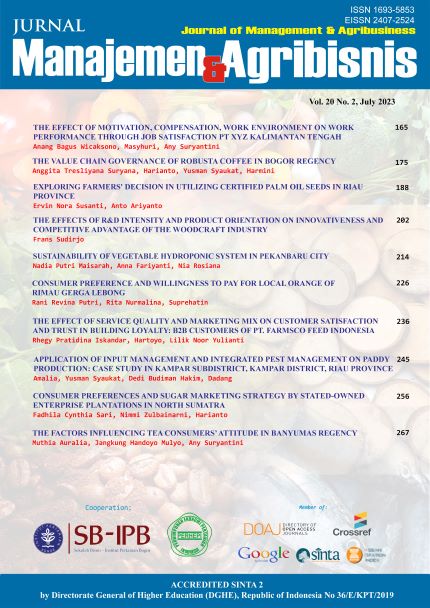The Factors Influencing Tea Consumers’ Attitude in Banyumas Regency
Abstract
Tea producers need to understand consumer perceptions of product attributes and consumer attitudes to face tough competition The large selection of products marks the lifestyle of the people in Banyumas Regency consuming tea every day. The research objective was to analyze the effect of scent, taste, brew color, brand, and price on consumer attitudes. The research locations were selected using purposive method, namely Sokaraja District and South Purwokerto Regency because they have the largest population and housing development in Banyumas Regency. The data collection through interviews with 175 tea consumer respondents was selected by convenience sampling, namely consumers who consumed black tea in packs of original tea bags and/or jasmine tea and made purchasing decisions within the household. The analytical method uses structural equation modelling to analyze the factors that influence consumer attitudes. Mostly, tea consumers are women with an average age of 43 years, are married with an undergraduate level of education, and have a household income above IDR 1,970,000. The results showed that floral scent, astringent taste, reddish brown brew color, brand popularity, and affordability price could explain consumer-perceived product attributes, and consumers' evaluation of various product choices could explain consumer attitudes. Consumer perception of taste and brand positively influences consumers. Tea producers should pay attention to consumers' perceived astringent taste of brewed tea and brand popularity because the consumer considers tea's two indicators important attributes.
Keywords: consumer perceptions, tea scent, tea taste, tea brew colour, consumer attitudes
Authors
Authors who publish with this journal agree to the following terms:
- Authors retain copyright and grant the journal right of first publication with the work simultaneously licensed under a Creative Commons Attribution License that allows others to share the work with an acknowledgement of the work's authorship and initial publication in this journal.
- Authors are able to enter into separate, additional contractual arrangements for the non-exclusive distribution of the journal's published version of the work (e.g., post it to an institutional repository or publish it in a book), with an acknowledgement of its initial publication in this journal.
- Authors are permitted and encouraged to post their work online (e.g., in institutional repositories or on their website) prior to and during the submission process, as it can lead to productive exchanges, as well as earlier and greater citation of published work (See The Effect of Open Access).

